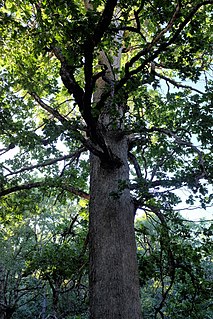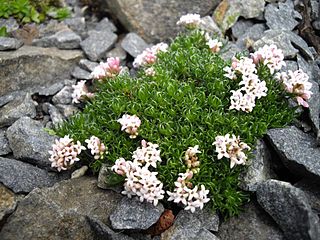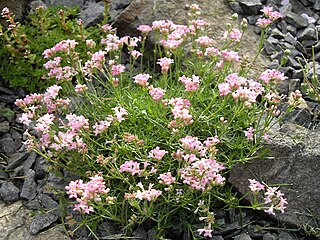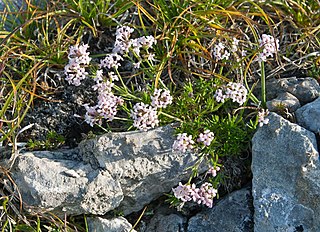
Petrorhagia is a small genus of annual and perennial plants of the family Caryophyllaceae, mostly native to the Mediterranean region. The genus is often referred to as Tunica, which is an obsolete synonym. It is low-growing with wiry stems and narrow, grass-like leaves. The flowers are small, in clusters similar to members of the genus Dianthus, in pink, lilac, or white. Petrorhagia saxifraga is the tunic flower or coat flower, similar to baby's breath, but shorter, and used in rock gardens.

Asperula, commonly known as woodruff, is a genus of flowering plants in the family Rubiaceae. It contains about 195 species and has a wide distribution area from Europe, northern Africa, temperate and subtropical Asia to Australasia.

Asperula orientalis, known as annual woodruff or oriental woodruff, is a species of flowering plant in the family Rubiaceae. It is found in Turkey, western Syria, Iraq, the Caucasus and Iran. It is often used as an ornamental plant in various regions and is reportedly naturalized in Oregon, North Dakota and the Czech Republic.
Umbilicus chloranthus is a species of flowering plant in the Crassulaceae family. It is referred to by the common names green Venus' navel and ombelico di Venere verdastro. It is native to Albania, the East Aegean Islands, Greece, Turkey, and Yugoslavia.
Gagea amblyopetala is a Eurasian species of plants in the lily family, Liliaceae. It is native to the Aegean Islands, Albania, Crete, Crimea, Greece, Italy, Sicily, Turkey, Yugoslavia. It is a bulb-forming perennial with yellow flowers.

Quercus vulcanica is a species of flowering plant in the Fagaceae family. It is referred to by the common name Kasnak oak, and is a rare species of tree native to Lebanon, Syria, and Turkey.
Asperula brachyantha is a species of flowering plant in the family Rubiaceae.
Asperula breviflora is a species of flowering plant in the family Rubiaceae. It was described in 1849 and is endemic to Syria.

Asperula gussonei, also known as alpine woodruff, is a deciduous species of perennial groundcover, and a flowering plant in the family Rubiaceae. It was first described in 1831 and is endemic to Sicily.

Asperula lilaciflora is a species of flowering plant in the family Rubiaceae.

Asperula nitida is a species of flowering plant in the family Rubiaceae. It was first described in 1806 and is endemic to Turkey.
Asperula podlechii is a species of flowering plant in the family Rubiaceae. It was first described in 2005 and is endemic to Afghanistan.
Asperula rumelica is a species of flowering plant in the family Rubiaceae. It was first described in 1856 and is endemic to Bulgaria, Greece, Romania, Russia, Turkey, and Ukraine.
Asperula serotina is a species of flowering plant in the family Rubiaceae. It was first described in 1982 and is endemic to Turkey.
Asperula taygetea is a species of flowering plant in the family Rubiaceae. Asperula taygetea was first described in 1849 and is endemic to Greece.

Ricotia is a genus of flowering plants in the family Brassicaceae, found in the Aegean islands, Crete, the Levant, the Sinai peninsula, Turkey, and the Transcaucasus. They appear to have arisen in Anatolia, to which five species are endemic.
Centaurea idaea is a species of flowering plant in the family Asteraceae. It is endemic to Crete.

Aquilegia ottonis is a species of flowering plant in the buttercup family. It has a broad distribution in Europe; it is native to Greece, Italy, and Albania. Plants produce blue-purple flowers which, based on pollination syndromes, are thought to be pollinated by bumblebees. A. ottonis is named after King Otto of Greece; the specific epithet 'ottonis' is the third declension of 'otto'.

Asperula abchasica is a deciduous species of perennial groundcover, and a flowering plant in the family Rubiaceae, known as Woodruff, and is endemic to Transcaucasus, and was first named by V.I Krecz.
Asperula acuminata is a deciduous species of perennial groundcover, and a flowering plant in the family Rubiaceae, known as Woodruff, and is endemic from NE. Turkey to Transcaucasus, and was first named by Boiss. & A.Huet.









